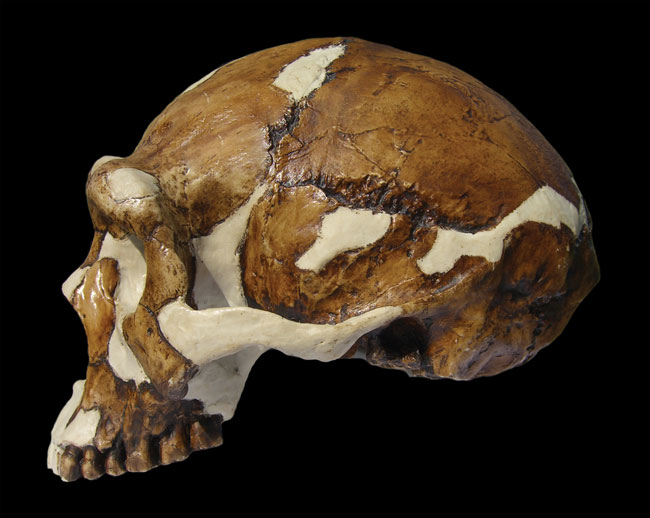Ancient 'Peking Man' Way Older Than Thought

The famous fossils of an early relative of modern humans commonly called Peking Man may be 200,000 years older than previously thought, a new study finds.
The revised date could change the timeline and number of migrations of the Homo erectus species out of Africa and into Asia. It also suggests that Peking Man endured glacial climates.
Previous studies estimated that H. erectus fossils found nearly a century ago in China were from about 500,000 years ago. The authors of the new study sought to re-date the fossils using a relatively new method that looks at the radioactive decay of aluminum and beryllium in quartz exposed to cosmic radiation. With this method, they pinned the date closer to 780,000 years ago.
Understanding the history of H. erectus is of interest to scientists because the populations of the species that lived in Africa are "implicated in the ancestry of modern humans," said paleoanthropologist Russell L. Ciochon of the University of Iowa in Iowa City, who was not involved in the new study.
Fossils found
H. erectus was a type of hominin, the group to which early and modern humans belong. H. erectus walked upright, had a thick skull with a brain a little smaller than our own and used stone tools.
The first fossils of the species were found on Java, Indonesia, in 1892 by Eugène Dubois.
Sign up for the Live Science daily newsletter now
Get the world’s most fascinating discoveries delivered straight to your inbox.
Nearly 30 years later, more H. erectus fossils were found thousands of miles away during excavations of the Zhoukoudian cave system just outside of Beijing.
These caves turned out to be "one of the most important Paleolithic sites in the world," the authors of the new study wrote. After the first fossil was found, anthropologists eventually turned up skulls and bones representing at least 40 H. erectus individuals, other mammal fossils and tens of thousands of stone artifacts.
The latest research on the fossils, funded by the National Natural Science Foundation of China and the Wenner-Gren Foundation, is detailed in the March 12 issue of the journal Nature. Guanjun Shen at Nanjing Normal University, China, headed up the study.
Glacial dwellers
Pushing back the date of the Zhoukoudian fossils puts them in closer range to fossils found in open basins and plains around the cave system that were originally dated to be much older than the Zhoukoudian fossils. It also shows that H. erectus lived in the area during glacial periods as well as during interglacial periods.
Many scientists thought that the species moved north with the interglacials and south with the glacials, Ciochon said. However, this new date shows they hung around during colder periods.
These glacial cycles didn't involve mounds of snow and ice as one might think, rather it was "just a colder, drier period," Ciochon told LiveScience.
The new date also sheds some light on how and when H. erectus got to the area in the first place.
Two migrations
The Homo genus, which includes modern humans, originated in Africa with Homo habilis about 2.5 million years ago. H. erectus likely derived from some early version of H. habilis around 2 million years ago, anthropologists think.
Some portion of the H. erectus population later left Africa and spread out across the Old World (the population left behind in Africa likely led to Homo heidelbergensis, from which the first early Homo sapiens likely derived, Ciochon said). Other sites of H. erectus bones show that the migration had reached Dmanisi, Georgia (in Asia), by about 1.75 million years ago and Java by about 1.6 million years ago.
"It's a species that had legs," Ciochon said, referring to the distances traveled. "Aside from Homo sapiens, it's the most widespread hominin species."
Some scientists had proposed that the Java population later migrated up to present-day China, but Ciochon said that the new date for the Zhoukoudian fossils lends credence to the idea that there could have been more than one migration route.
"Maybe there could have been two dispersals," he said. One route could have extended along the coast of Asia to Java, and another through the interior of Eurasia to Zhoukoudian and the surrounding areas.
Also supporting the double-migration idea is the fact that the Himalayas and a huge swath of primal forest unfriendly to hominin habitation lie in the way of a direct migration from Java to China.
Cinching this argument would likely require finding more sites with H. erectus fossils along the migration route, Ciochon said.
- Video – Similarities Between Humans and Other Primates
- Scientist: Human Origin Impossible to Pinpoint
- Top 10 Missing Links in Human Evolution

Andrea Thompson is an associate editor at Scientific American, where she covers sustainability, energy and the environment. Prior to that, she was a senior writer covering climate science at Climate Central and a reporter and editor at Live Science, where she primarily covered Earth science and the environment. She holds a graduate degree in science health and environmental reporting from New York University, as well as a bachelor of science and and masters of science in atmospheric chemistry from the Georgia Institute of Technology.










